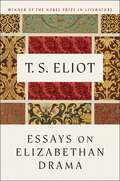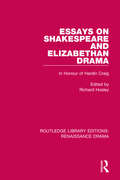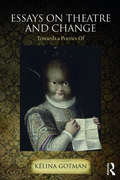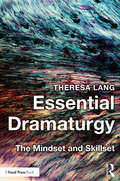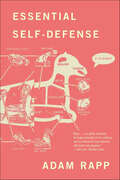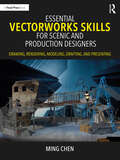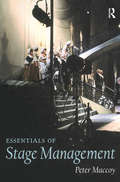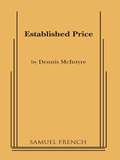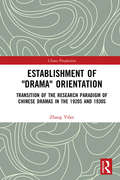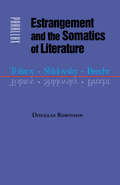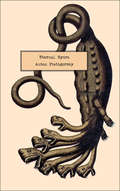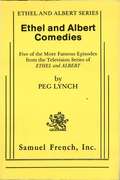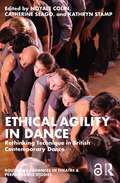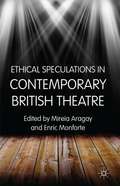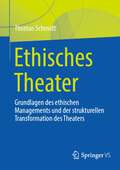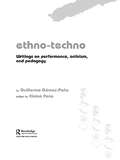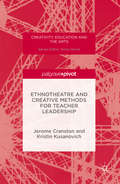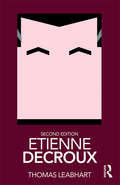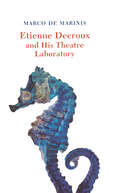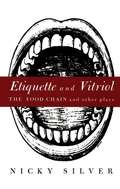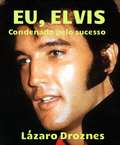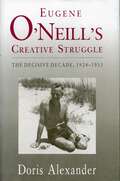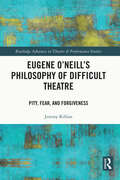- Table View
- List View
Essays On Elizabethan Drama
by T. S. EliotTouching on everyone from Marlowe to Middleton, Essays on Elizabethan Drama is a rigorous collection of Eliot’s works on the great dramatists of the 16th century.
Essays on Shakespeare and Elizabethan Drama: In Honour of Hardin Craig (Routledge Library Editions: Renaissance Drama #Vol. 5)
by Richard HosleyThe twenty-eight essays of this collection, first published in 1962, are the work of distinguished British, Canadian, and American scholars. The essays range widely over the field of Elizabethan drama, concentrating attention on Shakespeare and Marlowe but not neglecting earlier dramatists such as Kyd and Greene or later ones such as Heywood and Massinger. Among the general topics treated are the staging of the interludes, intrigue in Elizabethan tragedy, and Jacobean stage pastoralism. This title will be of interest to students of English literature.
Essays on Theatre and Change: Towards a Poetics Of
by Kélina GotmanIf theatre is a way of seeing, an event onstage but also a fleeting series of moments; not a copy or double but more vitally metamorphosis, transformation, and change, how might we speak to – and of – it? How do we envision and frame a fluid reality that moves faster than we can write? Arranged over two parts, 'Figurations' and 'Translations', Essays on Theatre and Change reflects on the animal, history, doubling, translation, and the performative potential of writing itself. Each fictocritical essay weaves between voices, genres and contexts to consider what theatre might be, offering a 'partial object' rather than a complete theory. Leaving the page radically open to its reader, Essays on Theatre and Change is a dazzling, multi-lensed account of what it is to think and write on theatre.
Essential Dramaturgy: The Mindset and Skillset
by Theresa LangEssential Dramaturgy: The Mindset and Skillset provides a concrete way to approach the work of a dramaturg. It explores ways to refine the process of defining, evaluating, and communicating that is essential to effective dramaturgical work. It then looks at how this outlook enhances the practical skills of production and new play dramaturgy. The book explains what a dramaturg does, what the role can be, and how best to refine and teach the skillset and mindset.
Essential Self-Defense: A Play
by Adam RappThe next work for the stage from the Pulitzer finalist Adam Rapp, Essential Self-Defense.In Essential Self-Defense, disgruntled misfit Yul Carroll takes a job as an attack dummy in a women's self-defense class and finds himself mysteriously drawn to Sadie, the repressed bookworm mercilessly honing her skills on him. Meanwhile, all's not well on the unassuming Midwestern streets of Bloggs: with local children vanishing at an alarming rate, our hero, his lady friend, and a motley assortment of poets, butchers, and punk librarians prepare to battle the darkness on the edge of town.
Essential Vectorworks Skills for Scenic and Production Designers: Drawing, Rendering, Modeling, Drafting, and Presenting
by Ming ChenEssential Vectorworks Skills for Scenic and Production Designers is an accessible textbook that covers the digital skills of 2D drawing, 3D modeling, rendering, drafting, and design presentation, providing aspiring designers with an invaluable toolkit to quickly and efficiently hone their craft.Modeled after learner-centered teaching practice and based on USITT drafting standards, this book is structured around six carefully selected core projects. It introduces key terms and commands, tools, techniques, and procedures for drawing, modeling, rendering, drafting, and design presentation with Vectorworks. Each chapter begins with key commands and a set of learning objectives that will be explored. The design exercises and projects that follow invite the reader’s active participation in the learning process. Along with step-by-step instructions, 240 illustrations (including student work samples), and three insightful interviews with professional designers, this book also contains open-ended projects that encourage the reader to explore new ways of scenographic expression and creatively apply commands and techniques to solve example design problems.This textbook is for use in scenic design, drafting, model making, and rendering courses in university theatre and media programs, and may be of interest to emerging professional scenic designers or scenographers for theatre, opera, and concert performances, production designers or art directors in film and television industries, themed exhibition designers, and theme park designers.Essential Vectorworks Skills for Scenic and Production Designers includes access to a wealth of online resources, including 15 videos with step-by-step instruction, six files of vwx or PDF formats for additional exercises and projects, and a video of student work samples.
Essentials of Stage Management (Backstage Ser.)
by Peter MaccoyFirst Published in 2005. Routledge is an imprint of Taylor & Francis, an informa company.
Established Price
by Dennis McintyreFull Length, Comedy / 4m / Interior / This timely comedy by the author of Split Second and Modigliani is a tale of white collar angst in this age of corporate takeovers. The central character, Frank Daniels played in regional productions by both Kenneth McMillan and Jason Robards, is the former general counsel for a cannibalized corporation and he does not intend to go gently into forced retirement. He refuses to pack, tears up the office, and tries to get his fellow executives to decline their golden parachutes as a protest. / "Taut and heart felt." Philadelphia Daily News.
Establishment of "Drama" Orientation: Transition of the Research Paradigm of Chinese Dramas in the 1920s and 1930s (China Perspectives)
by Zhang YifanThe “national drama” in China is a historical concept. Grown on longstanding Chinese culture and art, the traditional drama, mainly in the form of “opera”, has been integrated with “drama” of an international background. From the perspective of modern “drama and opera”, this book mainly studies the conditions and research of Chinese traditional drama in the 1920s and 1930s. Instead of analyzing from the viewpoint of literature appreciation or music theory, the author regards the drama as a comprehensive stage art. He attaches special importance to restoring historical scenes and therefore mainly introduces the drama journals and monographs published in that historical period, in order to help readers understand the original state of drama at that time through the records of the witnesses. In particular, this book delivers an insightful view about the evolution of the meaning of “national drama” and “drama”. The book will help scholars and readers understand the meaning and the whole story of the “national drama” concept, and will certainly facilitate the construction of the discipline of Drama and Opera.
Estado Vegetal: Performance and Plant-Thinking (Art After Nature)
by Giovanni AloiInterdisciplinary essays on Manuela Infante&’s award-winning play explore the relationship between critical plant studies and performance art in the Anthropocene Since its first staging in 2016, Estado Vegetal, Manuela Infante&’s riveting piece of experimental performance art, has expanded philosophical thinking into a fully-fledged artistic inquiry of nonanthropocentric being. Through Infante&’s polyvocal monologue, acted with impetus by Marcela Salinas, plants are charged with an agency capable of uprooting culturally grounded conceptions of the world in the face of incommensurable trauma and loss. This first book dedicated to Infante&’s plant-focused performance features eight essays by scholars, poets, and artists whose practices draw from research fields as disparate as new materialism, anthropogenic feminism, queer studies, and speculative realism. Including an interview with Infante, the full playscript, and stills from the performance, Estado Vegetal: Performance and Plant-Thinking reveals the roles that plants in art can play in productively reconfiguring human–nonhuman relations within current anthropogenic perspectives. Infante&’s performance is a perfect case study and reference point for anyone interested in exploring the complexities of plant-thinking through alternative and experimental avenues. Furthermore, this book is at once a critical plant studies primer and an artistic problematization of the philosophical questions that have been central to the latest multidisciplinary discussions on plant-being. Contributors: Maaike Bleeker, Utrecht U; Lucy Cotter, Portland State U; Prudence Gibson, UNSW Sydney; Michael Marder, U of the Basque Country; Dawn Sanders, U of Gothenburg; Catriona Sandilands, York U; Sibila Sotomayor Van Rysseghem, colectivo LASTESIS; Mandy-Suzanne Wong.
Estrangement and the Somatics of Literature: Tolstoy, Shklovsky, Brecht (Parallax: Re-visions of Culture and Society)
by Douglas RobinsonDrawing together the estrangement theories of Viktor Shklovsky and Bertolt Brecht with Leo Tolstoy's theory of infection, Douglas Robinson studies the ways in which shared evaluative affect regulates both literary familiarity—convention and tradition—and modern strategies of alienation, depersonalization, and malaise.This book begins with two assumptions, both taken from Tolstoy's late aesthetic treatise What Is Art? (1898): that there is a malaise in culture, and that literature's power to "infect" readers with the moral values of the author is a possible cure for this malaise. Exploring these ideas of estrangement within the contexts of earlier, contemporary, and later critical theory, Robinson argues that Shklovsky and Brecht follow Tolstoy in their efforts to fight depersonalization by imbuing readers with the transformative guidance of collectivized feeling. Robinson's somatic approach to literature offers a powerful alternative to depersonalizing structuralist and poststructuralist theorization without simply retreating into conservative rejection and reaction.Both a comparative study of Russian and German literary-theoretical history and an insightful examination of the somatics of literature, this groundbreaking work provides a deeper understanding of how literature affects the reader and offers a new perspective on present-day problems in poststructuralist approaches to the human condition.
Eternal Hydra
by Anton PiatigorskyNominated for several Dora Awards When a young scholar finds Eternal Hydra, a long-lost, legendary and encyclopedic novel by an obscure Irish writer, she brings the manuscript to an esteemed publisher, hoping to secure an international audience for the book. But Vivian's obsession with the dead author, who has materialized in her life, is challenged by the work of a contemporary historical novelist, and she's forced to face confounding questions about authorship, racism, and ethical behavior.Weaving between modern-day New York, 1930s Paris and New Orleans in the years following the Civil War, Eternal Hydra is a postmodern look at the making of a modernist masterpiece.'A play of such tight structure, such cerebral content and such sure drama that the thoughtful theatregoer could hardly fail to be impressed.' - Globe and Mail
Ethical Agility in Dance: Rethinking Technique in British Contemporary Dance (Routledge Advances in Theatre & Performance Studies)
by Noyale Colin Catherine Seago Kathryn StampThis edited collection examines the potential of dance training for developing socially engaged individuals capable of forging ethical human relations for an ever-changing world and in turn frames dance as a fundamental part of human experience. This volume draws together a range of critical voices to reflect the inclusive potential of dance. The contributions offer perspectives on contemporary dance training in Britain from dance educators, scholars, practitioners and artists. Through examining the politics, values and ethics of learning dance today, this book argues for the need of a re-assessment of the evolving practices in dance training and techniques. Key questions address how the concept of ‘technique’ and associated systems of training in dance could be redefined to enable the collaboration of skills and application of ideas necessary to twenty-first-century dance. The editors present these ideas in different modes of writing. This collection of essays, conversations and manifestos offers a way to explore, debate and grasp the shifting values of contemporary dance. Examining these values in the applied field of dance reveals a complex and contrasting range of ideas, encompassing broad themes including the relationships between individuality and collectivity, rigour and creativity, and virtuosity and inclusivity. This volume points to ethical techniques as providing a way of navigating these contrasting values in dance. It serves as an invaluable resource for academics as well as practitioners and students.
Ethical Speculations in Contemporary British Theatre
by Mireia Aragay Enric MonforteThis volume is the first to offer a comprehensive critical examination of the intersections between contemporary ethical thought and post-1989 British playwriting. Its coverage of a large number of plays and playwrights, international range of contributors and original argumentation make it a key point of reference for students and researchers.
Ethisches Theater: Grundlagen des ethischen Managements und der strukturellen Transformation des Theaters
by Thomas SchmidtMit dem Konzept des Ethischen Theaters wird ein ganzheitliches Zukunftsmodell vorgestellt. Ausgangspunkt ist die Analyse der gegenwärtigen Krisen und der Komplexität in den deutschsprachigen Theatern, um die Grundlagen für ihren Transformationsprozess zu entwickeln. Mit dem Ethischen Theater wird ein Ziel dieses Prozesses vorgestellt: das ganzheitliches Zukunftsmodell einer Theater-Organisation des 21. Jahrhunderts, in der ethische Überlegungen erstmals in allen Prozessen handlungsleitend sind. Das Modell ist kompatibel mit den Interessen der Stakeholder und den wichtigen Reformprozessen, es ermöglicht die anstehende strukturelle Modernisierung der Theaterbetriebe. Unterstützt wird es durch das Konzept des Ethischen Theatermanagements, das erstmals über die klassischen Funktionen hinaus auch Aspekte der Diversität, der Nachhaltigkeit, der Ethik und der Zukunftsfähigkeit adressiert. Mit den erweiterten Funktionen des ethischen Managements werden auch weitere Möglichkeitsräume für die Zukunft der Kultur-Organisationen eröffnet.
Ethno-Techno: Writings on Performance, Activism and Pedagogy
by Guillermo Gomez-PenaGuillermo Gómez-Peña has spent many years developing his unique style of performance-activism; his theatricalizations of postcolonial theory. In Ethno-Techno: Writings on Performance, Activism and Pedagogy, he pushes the boundaries still further, exploring what's left for artists to do in a post-9/11 repressive culture of what he calls 'the mainstream bizarre'.Over forty-five photos document his artistic experiments and the text not only explores and confronts his political and philosophical parameters; it offers groundbreaking insights into his, and his company's, methods of production, development and teaching.The result is an extraordinary and inspiring glimpse into the life and work of one of the most daring, innovative and challenging performance artists of our age.
Ethnotheatre and Creative Methods for Teacher Leadership
by Jerome Cranston Kristin KusanovichThis book addresses the lived challenges to teacher leadership. It illustrates an arts-based research approach that effectively highlights the broader context of relational dynamics between adults at school, using one-act plays to open up difficult conversations on complex issues. School leadership has, ostensibly, a performative dimension. Teacher leaders enact leadership from a more vulnerable platform than those with administrative positions, while they try to thrive in roles which are not always clear from their pre-service preparation. Early-career teachers are often not aware of the very real hazards that can accompany their initial foray into leadership. This book encourages creative thinking about how to enact the teacher role to better embed and advocate for a supportive and just system.
Etienne Decroux (Routledge Performance Practitioners)
by Thomas LeabhartEtienne Decroux is the primary creator of Corporeal Mime and one of modern theatre’s most charismatic innovators, known for his ground-breaking use of the body as the principal means of expression on stage. This second edition combines: an overview of Decroux’s life and work an analysis of Decroux’s Words on Mime, the first book to be written about this art a series of practical exercises offering an introduction to Corporeal Mime technique. As a first step towards critical understanding, and as an initial exploration before going on to further, primary research, Routledge Performance Practitioners are unbeatable value for today’s student.
Etienne Decroux and his Theatre Laboratory (Routledge Icarus Ser.)
by Marco de MarinisEtienne Decroux and His Theatre Laboratory is based on the long-awaited translation of Marco De Marinis' monumental work on mime in the twentieth century: Mimo e teatro nel Novecento (1993). Now revised and updated, the volume focuses specifically on the seminal role played by French mime artist and pedagogue Etienne Decroux. Mime is a theatrical form of ancient tradition. In the nineteenth century, it saw both apogee and crisis in the west with the realistic and gesticulating 'white pantomime'. In the twentieth century, it underwent a radical overhaul, transforming into an 'abstract' corporeal art that shunned imitation and narrative, and which instead tended towards the plastic, elliptic, allusive, and symbolic transposition of actions and situations. This book is the result of detailed investigations, based on contemporary accounts and obscure or unpublished materials. Through the examination of the creative, pedagogical, and theoretical work of the 'inventor' of the new mime art, Etienne Decroux, De Marinis focuses on the different assumptions underlying the various modes of the problematic presence of mime in the theatre of the twentieth century: from the utopia of a 'pure' theatre, attributed to the sole essence of the actor, to its decline into a closed poetic genre often nostalgically stuck in the past; from mime as a pedagogical tool for the actor to mime as an expressive and virtuosic means in the hands of the director.
Etiquette and Vitriol
by Nicky SilverThis collection brings together two of Silver's highly acclaimed and successful works, the long-running Off Broadway hit The Food Chain and Pterodactyls, with two of his earlier works, Fat Men in Skirts and Free Will and Wanton Lust.
Eu, Elvis: Condenado pelo sucesso.
by Lázaro Droznes Danilo Aguilar MirandaA trajetória de Elvis Presley é a trágica história de uma celebridade, vítima do próprio sucesso e das circunstâncias. Os adolescentes sonham em ser estrelas do rock, e Elvis se pergunta: "Com o que podem sonhar as estrelas do rock?". Com 23 anos de idade, Elvis já tinha conseguido muito mais do que havia sonhado em suas mais loucas fantasias, mas pouco depois se converte em prisioneiro de sua própria imagem, sentindo que sua vida já não lhe pertencia. Preso em um labirinto que ele mesmo havia construído. Esta obra de ficção recria os momentos mais significativos da vida do ídolo através de histórias curiosas e de suas canções, para revelar a sequência de circunstâncias que levaram uma celebridade a pagar o preço da fama com sua própria vida.
Eugene O'Neill's Creative Struggle: The Decisive Decade, 1924–1933
by Doris AlexanderIn Eugene O'Neill's Creative Struggle, Doris Alexander gives us a new kind of inside biography that begins where the others leave off. It follows O'Neill through the door into his writing room to give a blow-by-blow account of how he fought out in his plays his great life battles—love against hate, doubt against belief, life against death—to an ever-expanding understanding. It presents a new kind of criticism, showing how O'Neill's most intimate struggles worked their way to resolution through the drama of his plays. Alexander reveals that he was engineering his own consciousness through his plays and solving his life problems—while the tone, imagery, and richness of the plays all came out of the nexus of memories summoned up by the urgency of the problems he faced in them. By the way of O'Neill, this study moves toward a theory of the impulse that sets off a writer's creativity, and a theory of how that impulse acts to shape a work, not only in a dramatist like O'Neill but also in the case of writers in other mediums, and even of painters and composers. The study begins with Desire Under the Elms because that play's plot was consolidated by a dream that opened up the transfixing grief that precipitated the play for O'Neill, and it ends with Days Without End when he had resolved his major emotional-philosophical struggle and created within himself the voice of his final great plays. Since the analysis brings to bear on the plays all of his conscious decisions, ideas, theories, as well as the life-and-death struggles motivating them, documenting even the final creative changes made during rehearsals, this book provides a definitive account of the nine plays analyzed in detail (Desire Under the Elms, Marco Millions, The Great God Brown, Lazarus Laughed, Strange Interlude, Dynamo, Mourning Becomes Electra, Ah, Wilderness!, and Days Without End, with additional analysis of plays written before and after.
Eugene O'Neill's Creative Struggle: The Decisive Decade, 1924–1933 (G - Reference, Information and Interdisciplinary Subjects)
by Doris AlexanderIn Eugene O'Neill's Creative Struggle, Doris Alexander gives us a new kind of inside biography that begins where the others leave off. It follows O'Neill through the door into his writing room to give a blow-by-blow account of how he fought out in his plays his great life battles—love against hate, doubt against belief, life against death—to an ever-expanding understanding. It presents a new kind of criticism, showing how O'Neill's most intimate struggles worked their way to resolution through the drama of his plays. Alexander reveals that he was engineering his own consciousness through his plays and solving his life problems—while the tone, imagery, and richness of the plays all came out of the nexus of memories summoned up by the urgency of the problems he faced in them. By the way of O'Neill, this study moves toward a theory of the impulse that sets off a writer's creativity, and a theory of how that impulse acts to shape a work, not only in a dramatist like O'Neill but also in the case of writers in other mediums, and even of painters and composers. The study begins with Desire Under the Elms because that play's plot was consolidated by a dream that opened up the transfixing grief that precipitated the play for O'Neill, and it ends with Days Without End when he had resolved his major emotional-philosophical struggle and created within himself the voice of his final great plays. Since the analysis brings to bear on the plays all of his conscious decisions, ideas, theories, as well as the life-and-death struggles motivating them, documenting even the final creative changes made during rehearsals, this book provides a definitive account of the nine plays analyzed in detail (Desire Under the Elms, Marco Millions, The Great God Brown, Lazarus Laughed, Strange Interlude, Dynamo, Mourning Becomes Electra, Ah, Wilderness!, and Days Without End, with additional analysis of plays written before and after.
Eugene O'Neill's Philosophy of Difficult Theatre: Pity, Fear, and Forgiveness (Routledge Advances in Theatre & Performance Studies)
by Jeremy KillianThrough a close re-examination of Eugene O’Neill’s oeuvre, from minor plays to his Pulitzer-winning works, this study proposes that O’Neill’s vision of tragedy privileges a particular emotional response over a more “rational” one among his audience members. In addition to offering a new paradigm through which to interpret O’Neill’s work, this book argues that O’Neill’s theory of tragedy is a robust account of the value of difficult theatre as a whole, with more explanatory scope and power than its cognitivist counterparts. This paradigm reshapes our understanding of live theatrical tragedy’s impact and significance for our lives. The book enters the discussion of tragic value by way of the plays of Eugene O’Neill, and through this study, Killian makes the case that O’Neill has refused to allow Plato to define the terms of tragedy’s merit, as the cognitivists have. He argues that O’Neill’s theory of tragedy is non-cognitive and locates the value of a play in its ability to trigger certain emotional responses from the audience. This would be of great interest to students and scholars of performance studies, literature and philosophy.
